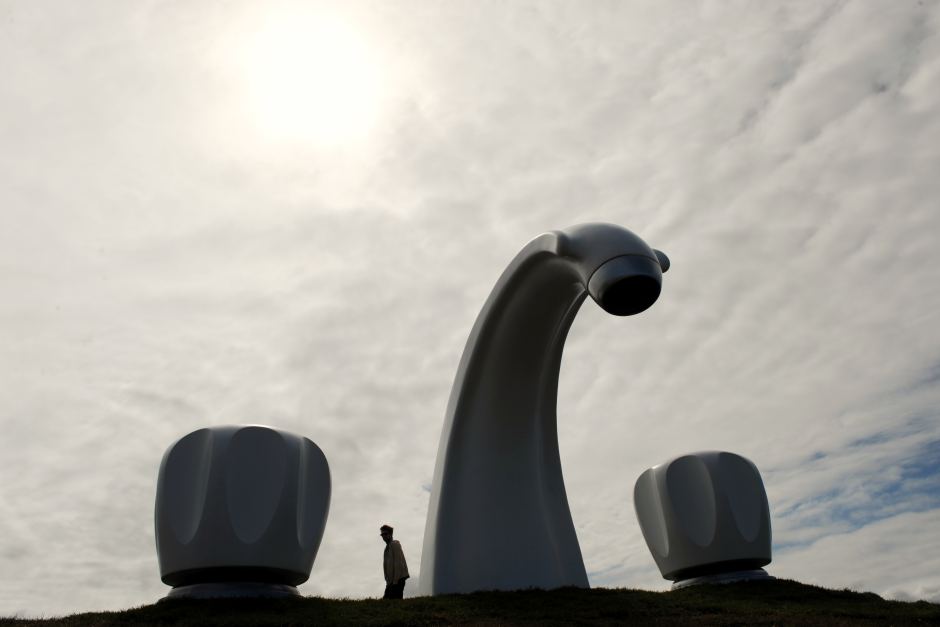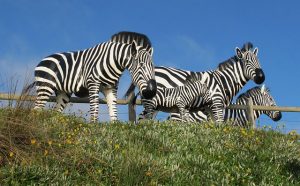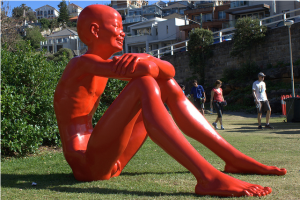To see what Sculpture by the Sea is really all about, one needs to go on a weekend, when the walk between Bondi and Tamarama is teeming with people. For most exhibitions this is the worst scenario for viewing works, but with SXS the open-air setting means that no piece is ever rendered inaccessible. The carnival atmosphere adds a dimension that no other show in Australia can match.
Sydney loves a great public event, but after fifteen years SXS is entitled to call itself an institution. Like other renowned art institutions, such as the Archibald Prize, SXS faces the peculiar challenge of maintaining credibility in the face of massive popularity. This is a problem unique to the arts, in which any exhibition, any novel or piece of music, which is picked up by the general public, is declared suspect. Because many believe true art is something that appeals only to those of refined sensibilities and intellect, there is an implicit insult in the idea of a show that aims to reach the broadest possible audience.
The argument runs: “If it’s popular it can’t be good, and vice versa.” It’s not exactly an argument, but a prejudice, because perceptions of quality are influenced by many factors. People make allowances for things that are ‘supposed’ to be trash, like the wretched Da Vinci Code; or have a superficial gloss of culture like Woody Allen’s Midnight in Paris. I mention these two examples because I feel they are both irredeemable.
There is no reason why a popular thriller must be badly written, and no virtue in making a cliché-ridden film that trades on the touristic glamour of a famous city. Stieg Larsson has shown that a thriller can be a worldwide best-seller and be an intelligent, stylish piece of writing. There are cinematic masterpieces set in non-descript places in which almost nothing happens. Think of the movies of the Japanese master, Yasujiro Ozu.
In the visual arts, while the going is good, museums and galleries can afford to put on their most rarefied shows. When funds get tight, they must turn to more popular fare. One sees this in the way the Australian Centre for the Moving Image in Melbourne has transformed its exhibiting program over the past two years. It looms as a challenge for Sydney’s renovated Museum of Contemporary Art when it re-opens next year. It is not credible that one can host unlovable exhibitions and ‘educate’ the public into liking them.
The crowds that turn up every year for SXS are unaware of the agonising that goes on behind the scenes. It is not simply the perennial problem of funding, there is also the issue of choosing a show that has a solid core of recognised sculptors, and enough novelty to appeal to audiences that come along for the entertainment value. Somewhere in the middle there is a charmed zone in which the specialist audience finds itself taken with some fresh, clever piece by an unknown artist; and the popular audience recognises the quality of an abstract work that might have been ignored in any other context.
This is art education in the truest sense – an unforced encounter with an object in a sympathetic environment. There are no long-winded labels and explanations, only the immediate experience of a huge variety of works, all identified as “sculpture”.
This year’s SXS is one of the busiest on record, with 109 pieces on display. It begins with the absurdist humour of a herd of fibreglass zebras by Alan and Julie Aston – the alternative collective noun is a “dazzle” – and ends with works such as Chen Wenling’s Childhood horizon, another of his trademark series of red boys which have become a highly popular addition to recent SXS shows.
Along the trail to Tamarama viewers will encounter many familiar names, including Ron Robertson-Swann, Michael Le Grand, Orest Keywan, Philip Spelman, Stephen King, and Japanese sculptors such as Keizo Ushio and Koichi Ishino – the latter being now officially an Aussie. Having been represented in the show ten times, Ishino becomes a part of the SXS decade club in 2011, along with that other mercurial talent, James Rogers.
The core of this year’s show is built around these artists, who have enjoyed long-term associations with SXS. Coming up through the ranks are sculptors such as Marcus Tatton and Alessandra Rossi, who along with James Rogers were the 2011 recipients of the $30,000 Helen Lempriere Scholarships.

Following on from last year, the leading overseas artist is Sir Anthony Caro, who takes second place to no other living sculptor. Nevertheless, Caro’s massive metal sculpture, Aurora (2005), is a rather pedestrian piece by his standards. Resembling a large turbine on a heavy base, it has none of the lyricism and complexity that distinguishes his best work. Even a bright red paint job fails to add the requisite dynamism.
In terms of subtlety and elegance, it’s hard to go past another abstract metal sculpture, Ron Robertson-Swann’s Inner Sanctum. Painted the same vivid red as the Caro, it suggests an altarpiece, enclosed by pieces of steel as deftly folded as a work of origami.

From an impressive group of works by younger sculptors one might single out Linda Bowden’s Descending the mountain, a beautifully conceived and coloured ensemble, in which a group of metal forms lean against one another in echo of a rocky landscape. The catalogue refers us to Duchamp’s painting, Nude descending a staircase, but this requires a leap of the imagination.
Dave Horton’s Three Madrigals also have a strong presence, with their tight, interlocking elements setting up a sense of rhythm and harmony that does justice to the musical title. Ayako Saito’s Moon’s siesta is more modest in scale, but remarkable for the economical way it conjures up both a torso and a landscape.
Paul Selwood’s Paradiegma metaphysic, which took out this year’s Balnaves Foundation Sculpture Prize, is a more introverted work than many of the others I’ve mentioned. Instead of the bright red favoured by his peers, Selwood has painted his piece a pale, grey-green. The work itself uses flat sheets of metal that have been sliced open in a angular manner and folded back in on themselves, creating an architectonic effect. To give this work the prize was a vote in favour of interiority, and a rejection of the exaggerated theatricality of so many other pieces.
If one were pining for theatre it’s hard to go past Ken Unsworth’s Look this way, with its gigantic skeleton suspended in space at the top of a ladder. Another highlight is Byeong Doo Moon’s I have been dreaming to be a tree… II, a stainless steel sculpture of a deer, in which the antlers twist and turn in space like the forms in Van Gogh’s Starry night. More prosaically, there’s Simon McGrath’s huge set of fibreglass taps, which are attracting more photographs than anything else in the show.

It may seem that SXS is such a comprehensive overview of local sculpture that nothing escapes its clutches. Defiance Gallery aims to show this is not the case with its annual 6X6X6 Inch Miniature Sculpture Show. While SXS places 109 sculptures across an expanse of shoreline, the Miniature Show manages to squeeze 124 sculptures into a single room.
SXS is fifteen years’ old, but the Miniature Show is celebrating its sixteenth birthday. With the notable exceptions of Anne Ferguson, Clara Hali, Geoff Harvey and Koichi Ishino, there is no crossover between the two exhibitions. This is partly because Defiance and SXS have been feuding ever since the latter decided to reduce the dealers’ commission on sales.
More significantly, it requires an entirely different mindset to make a miniature work that manages to be something more than a knick-knack. Take away the physical impressions of size and weight, and sculpture has to find another way of impressing itself upon the viewer. Some of the most inventive solutions have come from artists such as Michael Buzzacott and Jan King, who have made brilliant small works that are stylistically different from their larger scale pieces. Robert Bell’s abstract constructions are highly skillful exercises, while the figurative pieces of artists such as Randall Sinnamon and Salwa Hourani combine humour and tactility.

With more than two hundred sculptors showing their wares this week, it’s futile to keep singling out individuals. The moral of the story is that sculpture is not merely alive in this city, it is thriving. One need not expect an unbroken chain of masterpieces, but the vitality of the art should speak just as loudly to both the specialists and the public.
Published in the Sydney Morning Herald, November 12, 2011
Sculpture by the Sea 2011, Bondi to Tamarama, until 20 November
MiniMajors: The 16th Annual 6X6X6 Inch Miniature Sculpture Show, Defiance Gallery, Newtown, until 26 November



